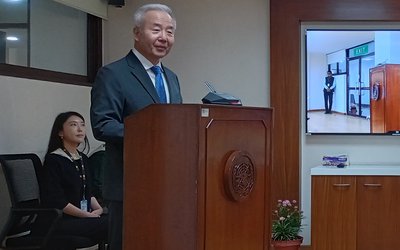
Practical Action South Asian Office has shown how an INGO can provide support to the government to launch a program like NAP for the benefit of the people and the country.
Having long experiences of jointly working with Nepal government and other stakeholders in the area of climate change, Practical Action has been an active partner of Nepal’s climate change support programs. Supporting the launching of NAP, Practical Action has shown again its commitments to collaboration and support.
Organized by Ministry of Science, Technology and Environment and Practical Action Nepal, the launching of NAP is another important milestone in Nepal’s climate change program after successfully implementing the NAPA and LAPA processes.
Inaugurating the NAP launching, member of National Planning Commission Dr. Bharatendu Mishra said this is a very important moment for Nepal as climate change has been gradually touching various sectors of Nepal, particularly the agriculture sector.
“As Nepal’s weather pattern is gradually changing, it has a major implication in the agriculture sector, particularly in the paddy and wheat product,” said Dr. Mishra. “We have no alternative other than to follow the adaptation to adopt with the climate. As it is a cross cutting issue, we need the support from the agencies like Practical Action to reduce the impacts.”
According to a study made by Ministry of Agriculture Development, there is drastic reduction of paddy in the central region where rainfall is unpredictable.
"The climate change is presently a major issue as it is going to affect the livelihood of people. Thus, NAP launching is very significant in this regard. Although it looks like a little bit in a reverse gear as NAP, which should come before NAPA, coming as it does at the last moment, launching of NAP process is a matter of achievement for the Ministry,” said Dr. K.C. Paudel, secretary at Ministry of Science, Technology (MoSTE) and Environment. Agriculture, forest, water resources and bio-diversity are going to affect climate change. Thus, the NAP process is very important for us.”
NAP process helps the developing countries identify climate risks, adaptation needs, and capacity gaps, and then begins to integrate adaptation into their national and sub-national development plans, policies, and programs for medium to longer terms.
The NAP is intended to ensure that climate change impacts are considered as part of development and sectoral decision-making. This approach helps countries protect development gains despite changing climate.
“As climate change is gradually affecting the livelihood, there are only two ways, adaptation and mitigation, in reducing the effects. Since Nepal contributes very insignificantly to global warming, it can support through adaptation,” said Joint secretary Ram Prasad Lamsal, who heads the climate change division and focal point of UNFCCC. “We have made many a success in NAPA and LAPA and launching of NAP is another milestone.”
“In our efforts to mobilize various stakeholders, Practical Action supported us in NAP launching program and we want another stakeholder’s support for another meeting,” said Lamsal.
Under the leadership of Ministry of Science, Technology and Environment (MoSTE) and supported by Climate Proofing Growth and Development (CPGD) program, Practical Action organized Nepal National Adaptation Plan formulation process launching workshop.
“We are happy to be part of launching of NAP. As it is a process for the long term, NAP is about the results in the coming 20 years. As NAP is a more interactive program, there is the need to have broader participation of stakeholders in it,” said Gehendra Gurung, head of Disaster and Climate Change of Practical Action. "As it is a long-term program, research is essential for the NAP process.”
Attended by various stakeholders from government, donors, INGOs and NGOs, experts and universities teachers, the event shared with MoSTE ideas on how to take NAP formulation process ahead. MoSTE encouraged the stakeholders to express their views and suggestions on it.
The United Nations Convention on Climate Change (UNFCCC), Least Developed Countries Expert Group (LEG), developed NAP guidance in 2012. It presents a flexible, stepwise approach to carrying out adaptation planning that includes assessing climate risks and vulnerabilities, identifying and prioritizing adaptation options, developing adaptation plans and implementation strategies, enhancing capacity, and creating systems to monitor and report on progress.
The complex, detailed nature of the NAP guidelines offers a comprehensive set of options for countries that need them. When a country’s planners select among the options to chart a “roadmap” for their particular NAP, the process should become quite a bit simpler.
The titles of the four NAP elements could be changed, or at least “translated.” These titles are negotiated text composed together by a large group late at night after long, contentious sessions in Durban.
NAP process has functioned almost entirely to support domestic decision-making. However, because the process was created under the UNFCCC, Parties to the UNFCCC could potentially give NAPs an internationally facing function under the new agreement as well.
From Ministry of Health and Population to ICIMOD and Federation of District Development Committee, university professors, NGOs representative, donor representatives exchanged their views and work done in their particular areas.
They also raised the questions on how to get involved in the process. As NAP has already rolled in following its launching, it will take a few more months to shape the NAP process. Although Ministry of Agriculture and Development and Ministry of Health have already started their programs on NAP, launching of the national program by focal Ministry is important.
As one of the early steps in a country’s NAP process is to chart a roadmap, which specifies the scope of the NAP process, roles and responsibilities of those involved, and the sequence of planning steps for that country, we are holding a series of programs in the coming days. The NAP process, on the other hand, is not currently linked directly to a funding source, and the Durban NAP decision specifically invites all developing countries, not just the least developed, to undertake NAPs. The Global Environment Facility has created a NAPs Support Program, which consists of a series of regional workshops and other technical assistance activities for LDCs launching NAPs.
- IME GROUP: Expands Into Paper Industry
- Mar 24, 2025
- CPN UML: Instigated By India
- Mar 23, 2025
- ADB’S CHIEF ECONOMIST: Nepal Reduces Poverty
- Mar 11, 2025
- FM DR. DEUBA: A Successful Visit
- Mar 11, 2025
- MD GHISING: Target Of Personal Grudge
- Mar 09, 2025















